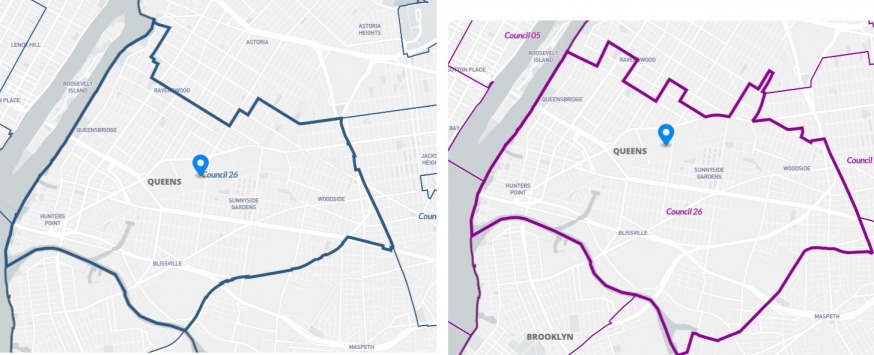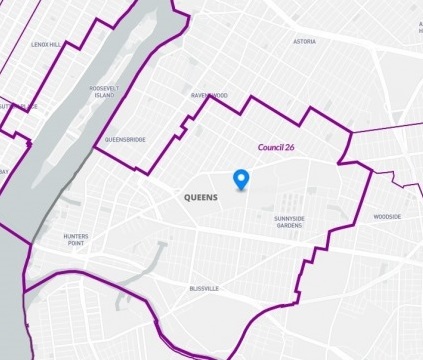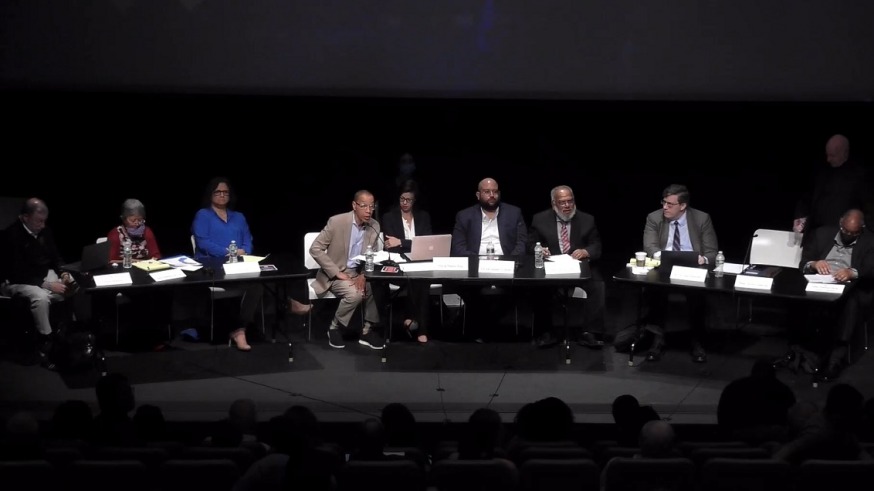
(Michael Appleton/ Mayoral Photography Office)
Oct. 7, 2022 By Christian Murray
The NYC Districting Commission released its revised maps Thursday and most of the controversial changes to District 26 under an earlier plan have been nixed and the district looks similar to what it is today.
The latest map is exclusively western Queens and no longer includes sections of the Upper East Side of Manhattan or Roosevelt Island that were part of a previous version that upset local community boards and elected officials on both sides of the East River.
The updated 26th District map is now centered on Sunnyside, Woodside and Long Island City.
The commission approved the revised District 26 map—along with the maps for the other 50 city council districts—by a 13-1 vote. The maps were the third to be crafted, following a preliminary set released in July and a revised plan that was struck down last month.

The current District 26 map (left), with the revised version released Oct. 6 to the right (Source: redistrictingandyou.org)
The initial changes to the 26th District proposed in July were significant—beyond the addition of Roosevelt Island and parts of the Upper East Side.
They called for splitting the Woodside portion of the existing district into four pieces—divided among districts 26, 30, 22 and 25. Additionally Ravenswood and Queensbridge would have been gone, swallowed up by District 22.
The updated map includes both Queensbridge and Ravenswood in the 26th District and preserves most of Woodside.
The commission’s latest map follows an avalanche of criticism.
At a public hearing held in August, hundreds of people turned out at the Museum of the Moving Image in Astoria to testify against the proposed changes to Council District 26.

The map released in July (above) added Roosevelt Island and parts of the Upper East Side to District 26. The map also cut Woodside into four districts. (Source: redistrictingandyou.org)
The plan for District 26 was criticized at that hearing on multiple fronts. Immigrant groups–particularly members of the Tibetan, Filipino, Bangladeshi, Colombian and Ecuadorian communities—said they opposed the changes, noting that the proposed split of Woodside would reduce their political voice and representation.
Others said that Sunnyside and Woodside are two neighborhoods that have been long tied together and should not be politically divided.
Meanwhile, residents of Manhattan opposed it, arguing that they would not be adequately represented—since 73 percent of the proposed district’s constituents would be in Queens.
Community Board 2 in Queens also opposed it and Councilmember Julie Won adamantly came out against it. Won said that the July proposal failed to adhere to the city charter.
The charter requires the commission in drafting the districts to keep neighborhoods and communities intact; keep them compact; limit crossover districts (a district should not cross borough lines to the maximum extent practicable); avoid odd-shaped districts; and not split voters of the same political party.
Maps that dilute the power of racial and language minorities are also prohibited.
“Looking at the preliminary council maps, it is painfully clear that no one on the NYC District Commission has read the City Charter,” Won said in July.

The NYC Districting Commission at the public hearing at the Museum of the Moving Image in Astoria in August. The meeting was led by Dennis Walcott, the commission chair (Photo: Screenshot of event)
Won complimented residents Friday for bringing the issues pertaining to the initial map to the commission’s attention.
“Our district had the highest turnout in the city for public comment after the release of the first draft of the maps,” Won said. “Our neighbors delivered powerful testimonies…. Upon hearing our outcry, many of the concerns have been addressed by the Redistricting Commission.”
The commission received more than 12,500 submissions pertaining to all 51 districts and more than 35 hours of public hearings.
Won said the revised plan is much better, getting rid of the crossover component that would have incorporated Roosevelt Island and parts of Manhattan into the district.
“It keeps Ravenswood, Queensbridge and Woodside Houses together, giving our NYCHA residents the opportunity to push for greater resources for public housing. It keeps Blissville [in the district], a small neighborhood with many environmental concerns and shelter residents, with its natural neighbors in Long Island City and Sunnyside.”
Won said she was disappointed to see that the Tibetan Community Center was not included in the latest 26th District map, noting that it has been politically separated from the many Tibetans who live in Sunnyside, Woodside, Long Island City and parts of Astoria.
“The Tibetan American community has been…part of District 26 since the 90s when they first sought asylum here as refugee seekers. Our Tibetan community should not be severed from the largest Tibetan community center and gathering place in the country,” Won said.
Morry Galonoy, chairperson of Community Board 2, said the map was a big improvement on what was initially proposed.
“We are pleased the NYC Districting Commission listened to the testimony of our board members and neighbors,” Galonoy said in a statement. “The new map approved by the Commission keeps our Queens-based council district mostly intact and does not include parts of Manhattan and Roosevelt Island that would put a strain on resources and representation for the Queens Community Board 2 district.”
The next step in the redistricting process is for the city council to review the maps. If the council approves them, they will go into effect in January 2024, with elections taking place for all 51 seats next year.
If the council rejects them then the commission is required to hold another round of public hearings and will then put together—and vote—on a final map by February without requiring the council’s approval.
One Comment






So they still have a modicum of common sense.